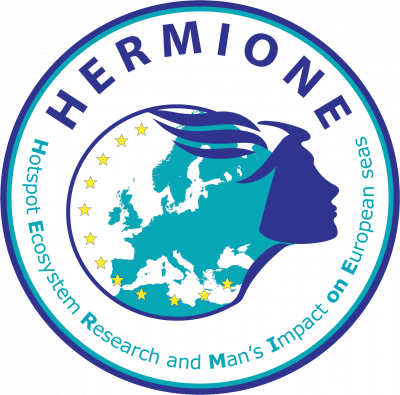- Home
- Discover
- Ship's logs
- Ship´s log POSEIDON 400
Ship´s log POSEIDON 400
This Ship´s log report on the work and life on board the research vessel POSEIDON.
The current position of the POSEIDON and further information about the expedition can be found here.
Do you have questions to the scientists on board? Just send an e-mail to:
Wednesday, July 14, 08:40 p.m.
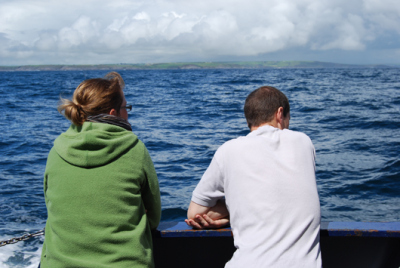
Claudia and Marco look at the coast of Ireland (picture: MARUM).
| Position of the ship |
| 51° 54’ North, 8° 27’ West Harbour of Cork, Ireland |
| Weather |
| Rain 15, 3° C |
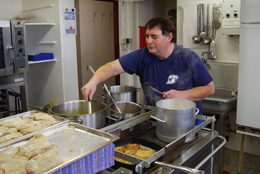
Cook Horst prepares the lunch (picture: MARUM).
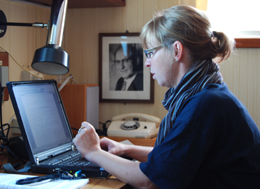
Claudia writes the cruise report (picture: MARUM).
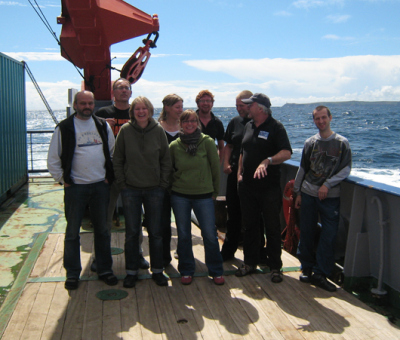
The cruise members of the 400. cruise of the POSEIDON: André, Götz, Jana, Lydia, Claudia, Mark, Markus, Werner und Marco (picture: MARUM).
For the last time greetings from the POSEIDON to all readers of our ship’s log, who came along with us on this cruise!
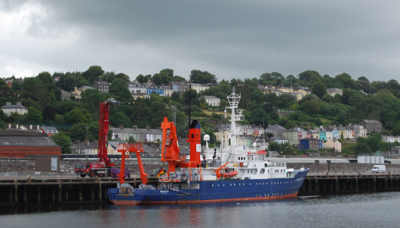
The POSEIDON in the harbour of Cork (picture: MARUM).
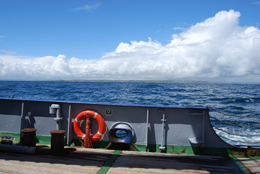
The POSEIDON in front of the coast of Ireland (picture: MARUM).

In Cork our container is lifted with a crane (picture: MARUM).
Tuesday, July 13, 09:11 p.m.
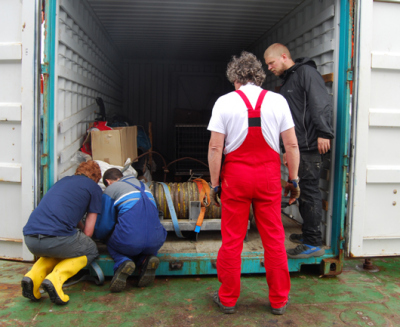
Boatman Achim is helping the three Ms with packing the container (picture: MARUM).
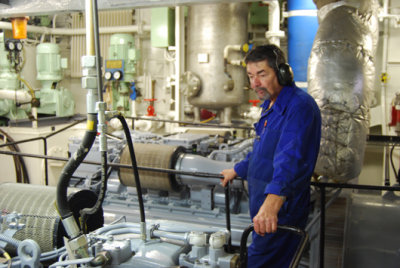
Motorman Rüdiger in the machine room (picture: MARUM).
| Position of the ship |
| 51° 26’ North, 11° 33’ West Porcupine Seabight, Macnas Mounds |
| Weather |
| Rain 15, 0° C, Wind: 4 Beaufort |
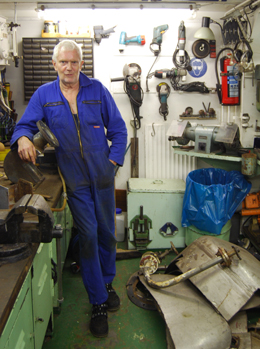
Engineer Heiko at the work bench (picture: MARUM).
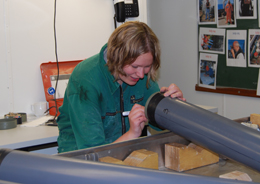
Jana labels the cores in the lab (picture: MARUM).
Greetings from all cruise members on board the POSEIDON!
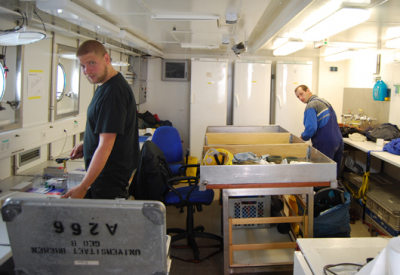
Markus and Marco packing the lab equipment together (picture: MARUM).
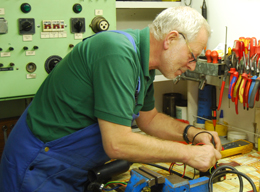
Electrician Dietmar at the working bench (picture: MARUM).
Monday, July 12, 07:15 p.m.
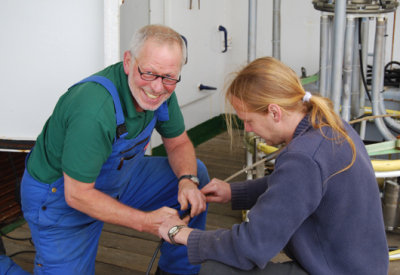
Electrician Dietmar and engineer Kurre repair the cable of the winch (picture: MARUM).
Greetings from all cruise members on board the POSEIDON!
| Position of the ship |
| 51° 33’ North, 11° 35’ West Porcupine Seabight, Macnas Mounds |
| Weather |
| Overcast 14, 4° C, Wind: 1 Beaufort |
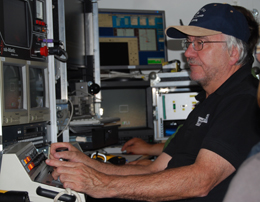
Werner navigates the CHEROKEE over the Macnas Mounds (picture: MARUM).
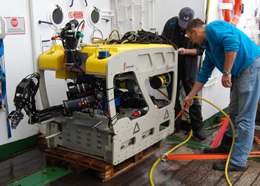
After the dive Götz rinses off mud and saltwater from the CHEROKEE (picture: MARUM).
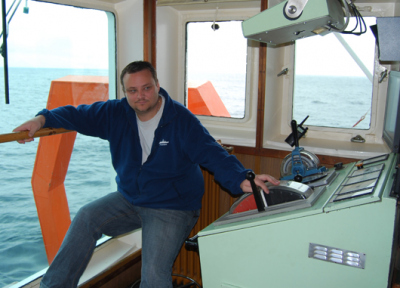
Second officer Alexander Hänsel holds the ship on its position during the dive (picture: MARUM).
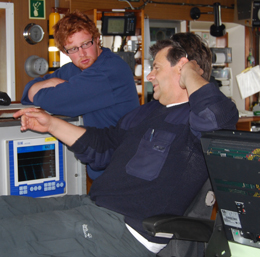
Mark and Captain Oliver Secchi at the bridge (picture: MARUM).
Sunday, July 11, 08:09 p.m.
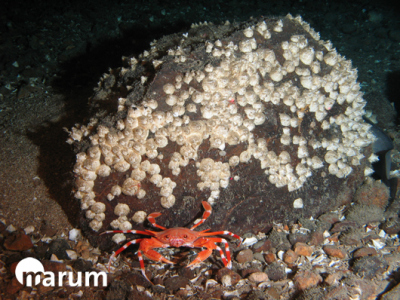
A very big dropstone (diameter about 1.5 metre) colonised by barnacles. In the foreground a deep sea swimming crab and more dropstones (picture: MARUM).
| Position of the ship |
| 51° 20’ North, 11° 49’ West Porcupine Seabight, Poseidon Mound |
| Weather |
| Overcast 15, 1° C, Wind: 4 Beaufort |
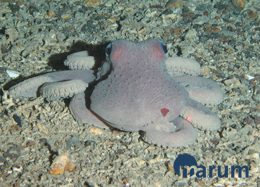
We as observers are also observed: a curious octopus eyes the CHEROKEE (picture: MARUM).
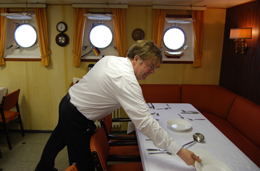
Steward Uli is setting the tables in the mess for lunch (picture: MARUM).
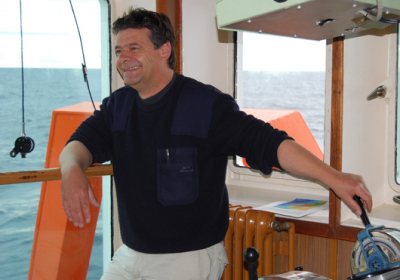
Captain Oliver Secchi holding the ship at the position during the ROV deployment (picture: MARUM).
Greetings from all cruise members on board the POSEIDON!
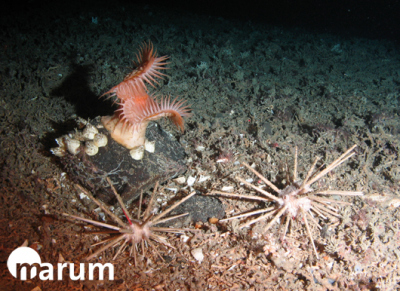
A fly-trap anemone and barnacles on a drop stone, in front two sea urchins. Around the stones there lays coral rubble (picture: MARUM).
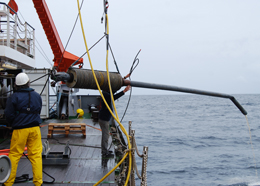
The gravity corer hit hard substrate and came back as a “banana” on board (picture: MARUM).
Saturday, July 10, 10:15 p.m.
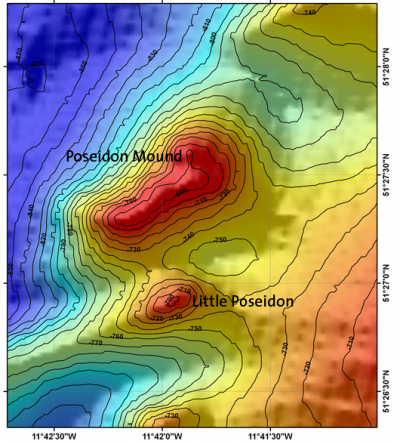
Bathymetrical chart of the coral mounds Poseidon and Little Poseidon (copyright: Andreas Beyer).
Greetings from all cruise members on board the POSEIDON!
| Position of the ship |
| 51° 37’ North, 11° 55’ West Porcupine Seabight, Poseidon Mound |
| Weather |
| Sunny 14, 4° C, Wind: 5 Beaufort |
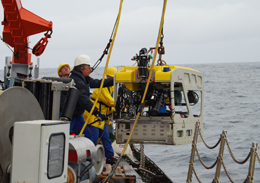
The CHEROKEE is launched (picture: MARUM).
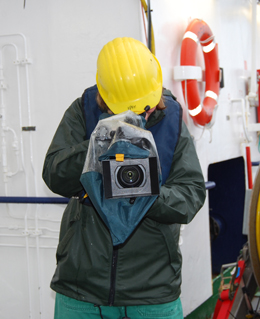
Jana is filming the work on deck (picture: MARUM).
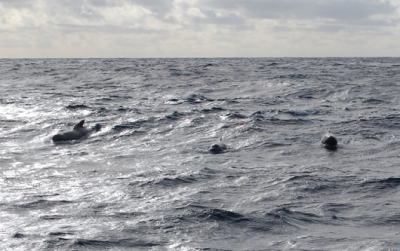
Whales came very closely to the POSEIDON (picture: MARUM).
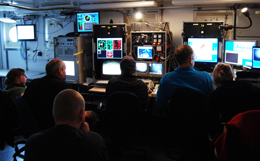
All cruise members watching the dive of the CHEROKEE on screens of the control station (picture: MARUM).
Friday, July 09, 06:08 p.m.
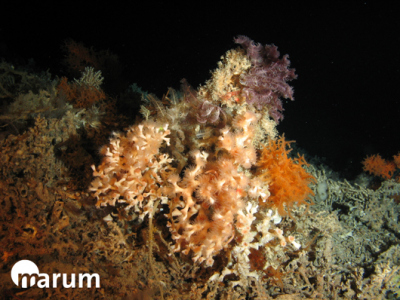
Stone coral thicket with various species of corals, such as Lophelia pertusa and Madrepora oculata (picture: MARUM)
| Position of the ship |
| 51° 20’ North, 11° 41’ West Porcupine Seabight, Lions Head Mound |
| Weather |
| Rain 14, 7° C, Wind: 5 Beaufort |
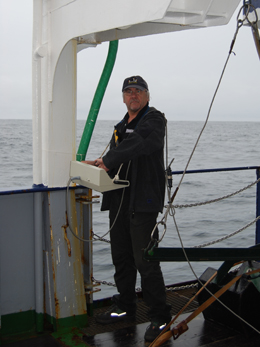
As long as the CHEROKEE is visible at the surface, Werner can navigate it with a portable control panel (picture: MARUM).
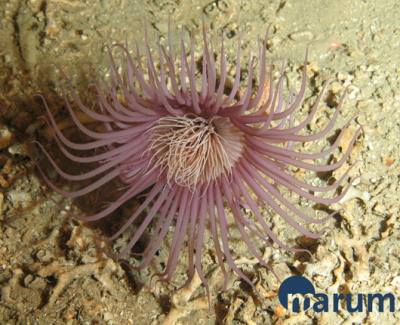
A cylinder rose (Cerianthus) (picture: MARUM)
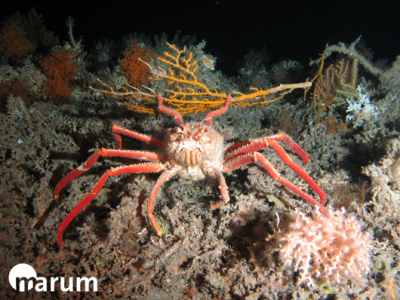
A carrier crab (Paromola cuvieri) with a gorgonian coral in its hind legs (picture: MARUM)
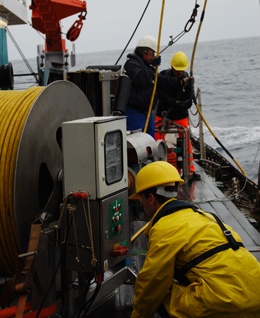
Marco operates the winch while CHEROKEE is diving (picture: MARUM).
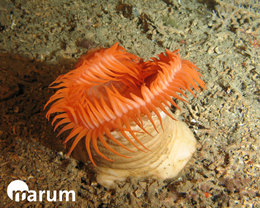
A flytrap anemone (Actinoscyphia) (picture: MARUM)
Greetings from all cruise members on board the POSEIDON!
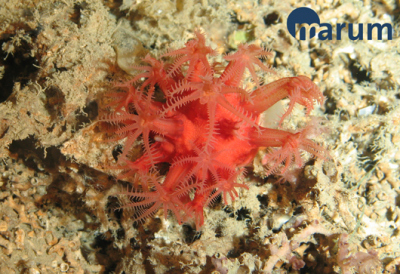
A colony of octocorals of the species Anthomastus grandiflorus (picture: MARUM)
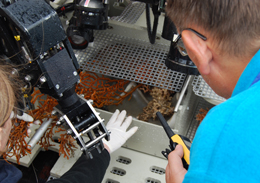
In a drawer CHEROKEE brings the collected samples from the sea floor on board (picture: MARUM).
Thursday, July 08, 08:52 p.m.
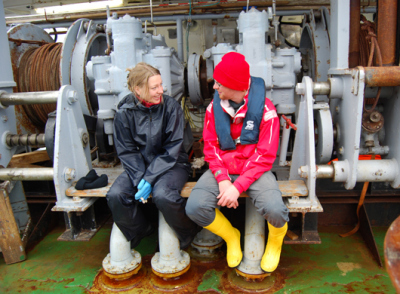
Lydia and Mark waiting on the afterdeck for the next grab sample (picture: MARUM).
| Position of the ship |
| 51° 28’ North, 12° 07’ West Porcupine Seabight, Poseidon Mound |
| Weather |
| Overcast 14, 8° C, Wind: 3 Beaufort |
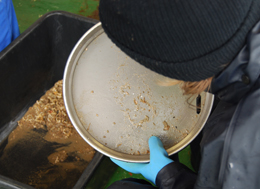
Lydia checks fine-grained material she caught with a sieve (picture: MARUM).
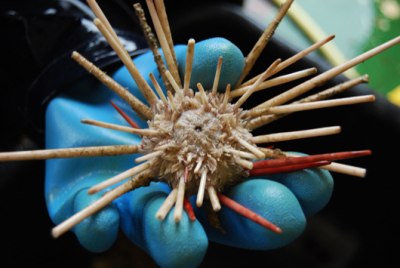
A sea urchin from the grab sample (picture: MARUM).
Greetings from all cruise members on board the POSEIDON!
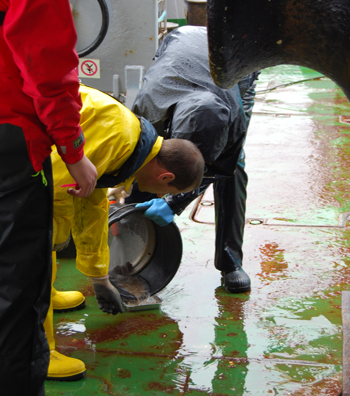
Marco and Lydia rinsing a subsample out of the sieve into an aluminium tray (picture: MARUM).
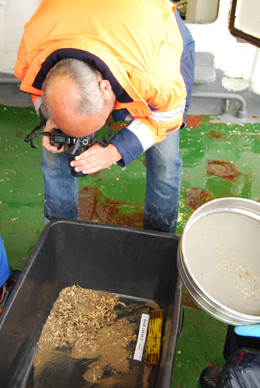
André taking pictures of the sample (picture: MARUM).
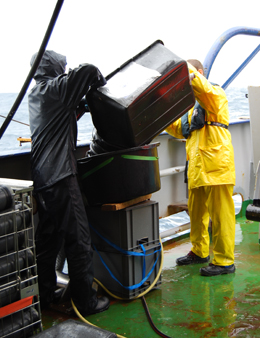
Lydia and Marco pouring the sample over the sieves (picture: MARUM).
Wednesday, July 07, 10:52 p.m.
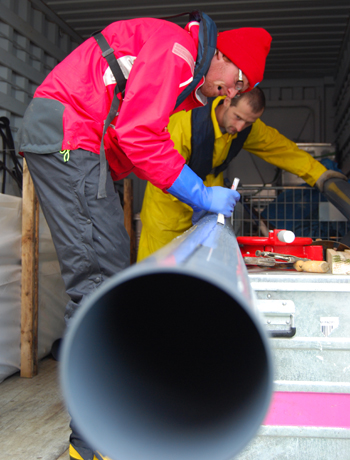
Mark and Marco draw the line onto the plastic pipe (picture: MARUM).
| Position of the ship |
| 51° 20’ North, 12° 18’ West Porcupine Seabight, Pollux Mound and Poseidon Mound |
| Weather |
| Overcast 15, 3° C, Wind: 5 Beaufort |
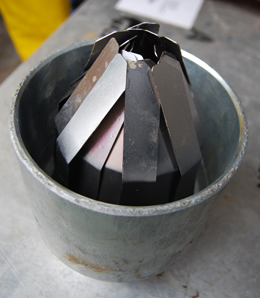
The core catcher will be fixed on the lower end of the gravity corer and prevent the sample from getting lost on the way up (picture: MARUM).
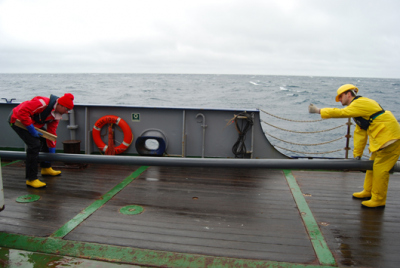
Mark and Marco pushing the plastic pipe into the steel pipe of the gravity corer (picture: MARUM).
Greetings from all cruise members on board the POSEIDON!
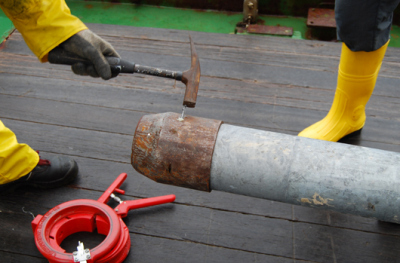
The core catcher is fixed with nails on the pipe (picture: MARUM).
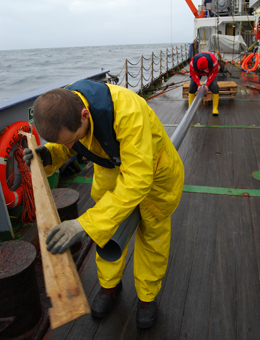
Marco and Mark pushing the plastic pipe into the steel pipe of the gravity corer (picture: MARUM).

The end of the gravity corer is greased before putting on the core catcher (picture: MARUM).
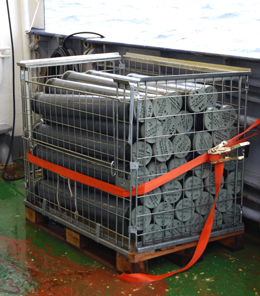
One box is already filled with cores (picture: MARUM).
Tuesday, July 06, 08:31 p.m.
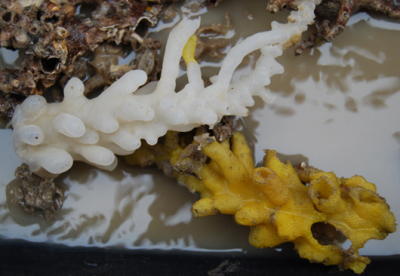
Glass sponges from the grab sample (picture: MARUM).
| Position of the ship |
| 51° 22’ North, 12° 06’ West Porcupine Seabight, Pollux Mound |
| Weather |
| Overcast 16, 3° C, Wind: 6 Beaufort |
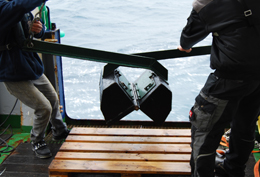
The grab sampler is fixed before it is dropped down to the sea floor (picture: MARUM).
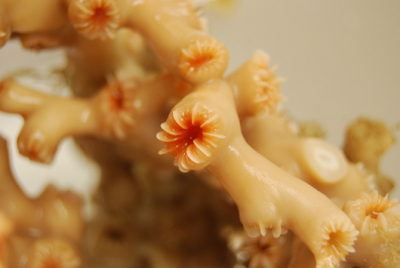
The cold-water coral Lophelia pertusa occurs in colonies (picture: MARUM).
Greetings from all cruise members on board the POSEIDON!
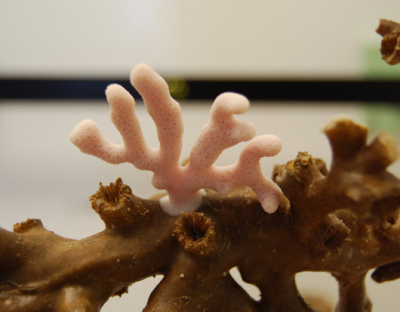
The calcified hydrozoa Pliobothrus belongs to the Stylasteridae (picture: MARUM).
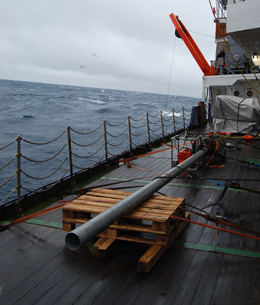
With the winch over the working deck the grab sampler is dropped down to the sea floor. The gravity corer stays lashed on the deck today (picture: MARUM).
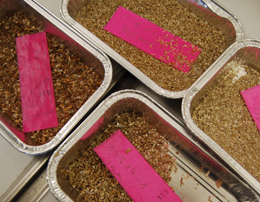
The subsamples divided into different size groups are dried in aluminium trays (picture: MARUM).
Monday, July 05, 09:37 p.m.
First we took eight samples with the grab sampler in different water depths of 730 to 800 meters. Its two buckets have to be fixed before dropping the device down to the sea floor. When it touches the ground both buckets snap automatically and bring the sample securely on board. Here the samples are received starry-eyed by our colleagues from the Senckenberg Institute (SaM). First they took some pictures of the samples and made a review of the material by noting what the grabber brought up to the day light. Besides different species of cold-water corals they found worms, snails, crabs, sponges, sea urchins and much more. For further analyses in the lab, subsamples were removed before rinsing the remains with water over different sized sieves. The samples, then grouped to fractions with different particle sizes, were stored for several hours in the drying cupboard.
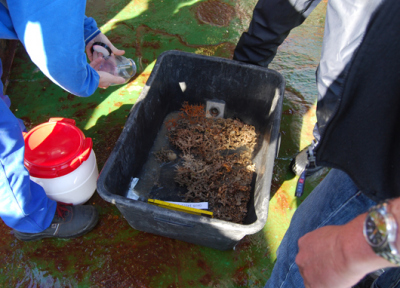
Everybody wants to have a look at the sample (picture: MARUM).
| Position of the ship |
| 51° 20’ North, 11° 41’ West Porcupine Seabight, Lions Head |
| Weather |
| Sunny 15, 4° C, Wind: 3 Beaufort |

The grab sampler is heaved on board again (picture: MARUM).
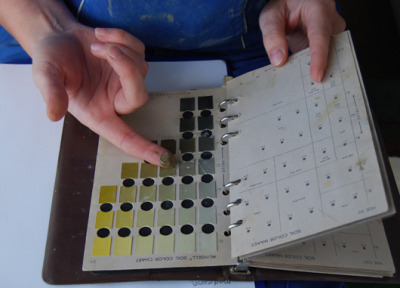
With the help of a colour chart for sediments Claudia defines the colour of our sample (picture: MARUM).
Greetings from all cruise members on board the POSEIDON!
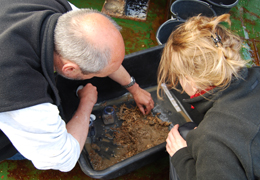
André and Lydia above the grab sample (picture: MARUM).
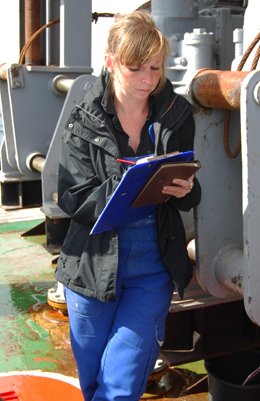
Claudia notes the first review of the grab sample (picture: MARUM).
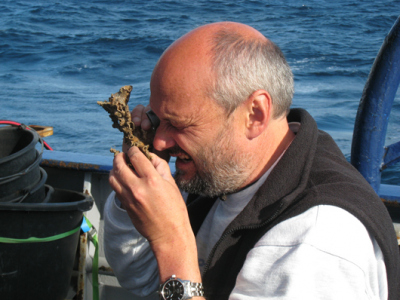
André examining a coral with a hand-lens (picture: MARUM).
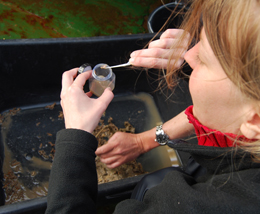
Lydia is taking subsamples for further analyses in the lab (picture: MARUM).
Sunday, July 04, 11:11 p.m.
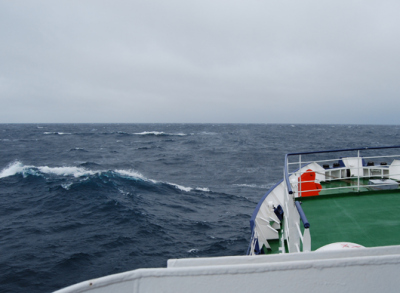
View to the bow (picture: MARUM).
Greetings from all cruise members on board the POSEIDON!
| Position of the ship |
| 51° 19’ North, 11° 38’ West Porcupine Seabight |
| Weather |
| Overcast 14, 8° C, Wind: 4 Beaufort |
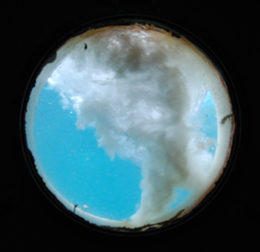
View out of the bull’s-eye (normally above sea surface) (picture: MARUM).
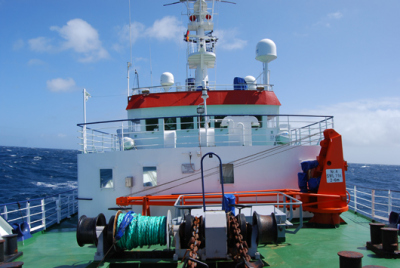
The POSEIDON seen from the foredeck (picture: MARUM).
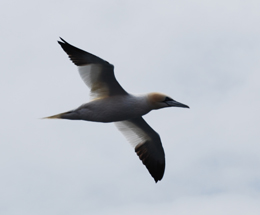
One of the many northern gannets come along with the ship (picture: MARUM).
Saturday, July 03, 9:28 p.m.
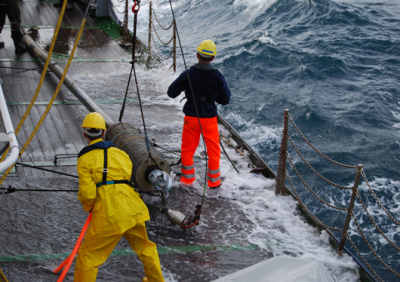
The gravity corer filled with sediment back on the deck (picture: MARUM).
| Position of the ship |
| 51° 32’ North, 11° 36’ West Porcupine Seabight |
| Weather |
| Overcast 15, 8° C, Wind: 6 Beaufort |
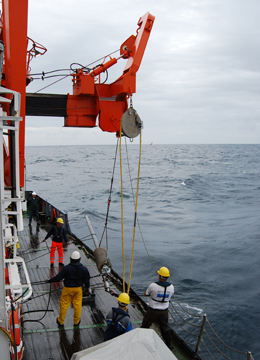
The gravity corer is launched (picture: MARUM).
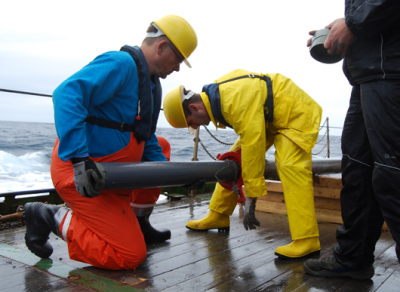
Götz and Marco cutting up the core into one meter sections. Markus has already the caps ready to close the sections (picture: MARUM).
Greetings from all cruise members on board the POSEIDON!
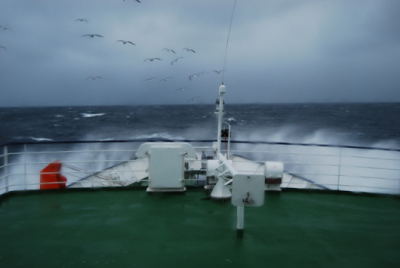
View over the bow at rough sea (picture: MARUM).
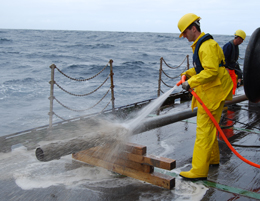
Marco rinsing the sediment remnants off the pipe (picture: MARUM).
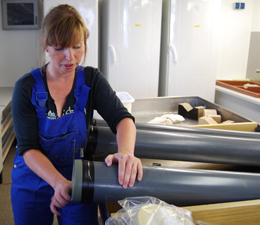
Claudia taping the caps onto the pipe ...
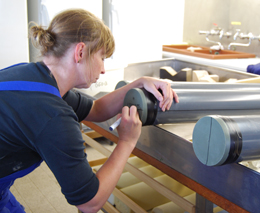
... and labelling the cores (pictures: MARUM).
Friday, July 02, 10:15 p.m.
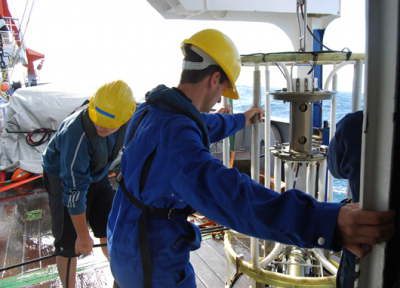
Seaman Gent and Marco launching the rack with the CTD probe (picture: MARUM).
| Position of the ship |
| 51° 21’ North, 11° 42’ West Porcupine Seabight |
| Weather |
| Overcast 15, 2° C, Wind: 6 Beaufort |
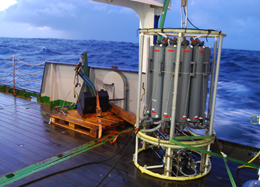
In the morning at 6:00 a.m. the sea was too rough to operate the CTD probe (picture: MARUM).
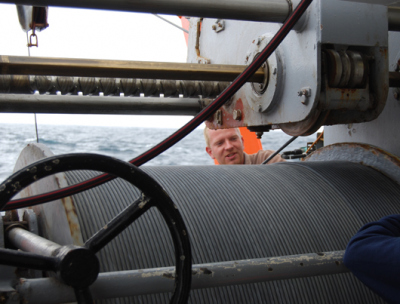
Seaman Ralf operating the winch that heave and veer the probe (picture: MARUM).
Greetings from all cruise members on board the POSEIDON!
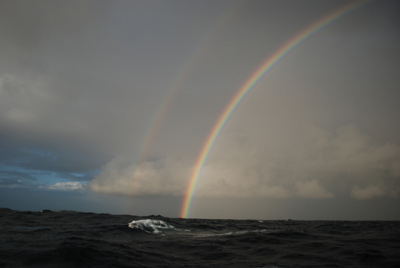
A short shower gave us this beautiful sight at the evening sky (picture: Lydia Beuck, SaM).
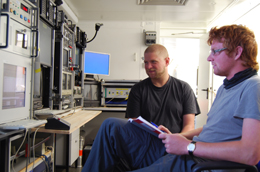
Markus and Mark checking the measurements of the CTD probe (picture: MARUM).
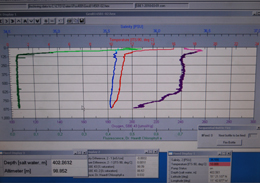
The data measured with the CTD probe is recorded and processed with this programme (picture: MARUM).
Thursday, July 01, 9:35 p.m.
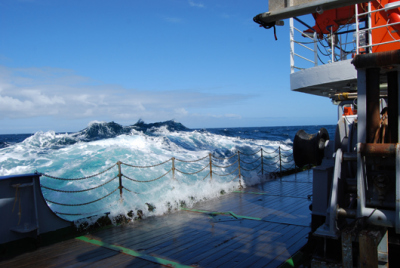
A wave swashing over the working deck (picture: MARUM).
| Position of the ship |
| 50° 46’ North, 11° 35’ West On the way to the study site |
| Weather |
| Overcast 16,5° C, Wind: 6 Beaufort |
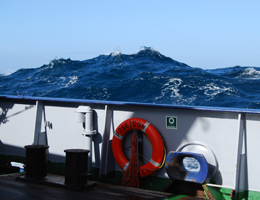
Some waves mount up so high, that the horizon disappears behind them (picture: MARUM).
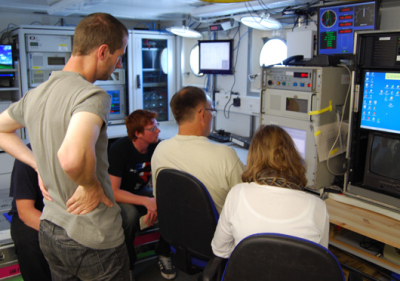
Götz explains the operation programmes for the CTD probe to Marco, Markus, Mark (yes, we are already thinking of some nicknames) and Claudia (picture: MARUM).
Greetings from all cruise members on board the POSEIDON!
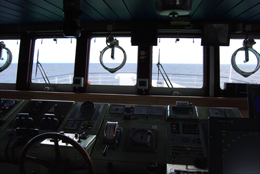
On the bridge of the POSEIDON (picture: MARUM).
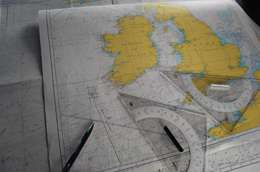
Course and investigation area are plotted into the sea charts (picture: MARUM).
Wednesday, June 30, 9 p.m.
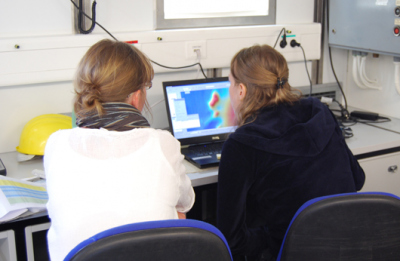
Claudia and Lydia locating the tracks for the dives of the CHEROKEE (picture: MARUM).
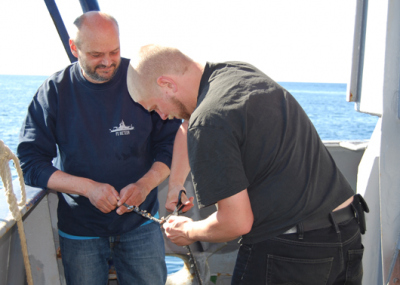
André and Markus cut some parts of the retrieved rope to study the organism that colonised the rope (picture: MARUM).
| Position of the ship |
| 47° 16’ North, 10° 51’ West On the way to the study site |
| Weather |
| Overcast 19,4° C, Wind: 6 Beaufort |
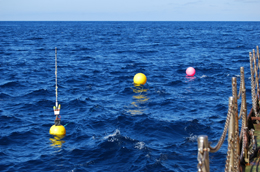
These buoys drifting towards the POSEIDON were probably cut loose (picture: MARUM).
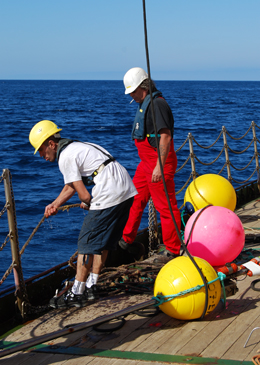
Seaman Pedro and boatsman Joachim retrieve the buoyancy material which turned out to be remains of a fishing net (picture: MARUM).
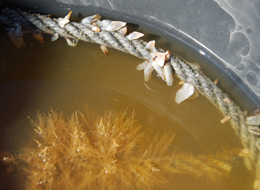
Goose barnacles and hydrozoa stick to the rope (picture: MARUM).
Greetings from all cruise members on board the POSEIDON!
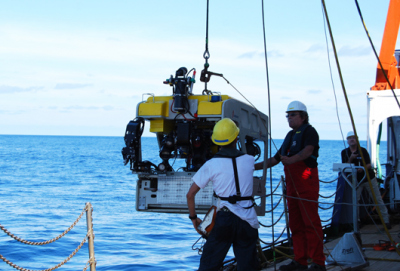
Pedro and Joachim launching the CHEROKEE (picture: MARUM).

At the control station Götz operates the CHEROKEE (picture: MARUM).
Tuesday, June 29, 11:45 p.m.
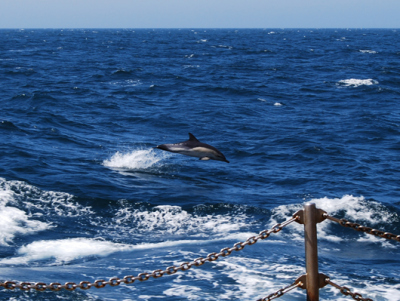
Dolphins are joining us on our way to the study site (picture: MARUM).
| Position of the ship |
| 44° 16’ North, 09° 51’ West On the way to the study site |
| Weather |
| cloudless sky 18, 6 ° C, Wind: 2 Beaufort |
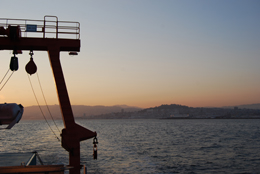
The POSEIDON steams out of the harbour of Vigo at sunrise (picture: MARUM).
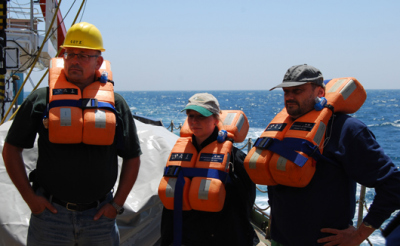
Götz, Claudia and André with their life jackets at the security training (picture: MARUM).
Greetings from all cruise members on board the POSEIDON!
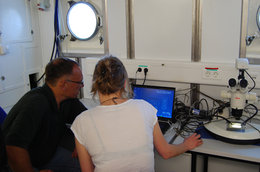
Lydia and Götz install the microscopy camera in the lab (picture: MARUM).

The research vessel POSEIDON in the harbour of Vigo (picture: MARUM).




